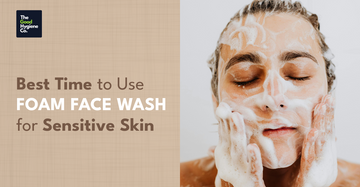Do you ever wonder if the time of day affects how well your skincare works? If you have sensitive skin, this question matters more than you think. Sensitive skin is easily irritated, which means the products you use—and when you use them—can impact how your skin reacts.
In this blog, we’ll break down the best time to use foam face wash for sensitive skin, why it matters, and how to build a gentle cleansing routine that calms your skin rather than aggravates it.
Why Timing Matters in Skincare
Skin isn't static—it goes through a natural rhythm every day. These rhythms affect how your skin absorbs products, produces oil, and responds to environmental factors.
For example:
- Morning: Your skin prepares to face the day—pollution, UV rays, makeup, and more.
- Evening: It shifts into repair mode, regenerating and recovering from daytime damage.
So, when you use your foam face wash for sensitive skin plays a role in how effective it is and how your skin feels afterward.
What Is a Foam Face Wash and Why Is It Good for Sensitive Skin?
A foam face wash is a cleanser that creates a light, airy lather to gently remove dirt, oil, sweat, and makeup without needing to scrub hard.
For those with sensitive skin, foam cleansers are often preferred because:
- They are less abrasive than gels or scrubs
- Many are soap-free and pH-balanced
- They cleanse effectively without stripping natural oils
However, not all foam face washes are created equal. Choosing one specifically formulated as a foam face wash for sensitive skin is crucial.
Look for labels that mention:
- Dermatologist-tested
- Fragrance-free or hypoallergenic
- Free from harsh sulfates and alcohol
- Infused with calming ingredients like chamomile, allantoin, panthenol, or green tea
Morning: The Ideal Start with Foam Face Wash for Sensitive Skin
Best Use Case: Gentle Removal of Nighttime Build-up
You might think your face is clean after a night’s sleep, but your skin produces oils and sheds dead cells even while resting. In addition, pillowcases can harbor dust, sweat, or skincare residue.
Using a foam face wash for sensitive skin in the morning helps:
- Gently remove overnight oil and dead skin
- Create a fresh, clean base for sunscreen and moisturizer
- Prevent clogged pores and irritation during the day
Morning Skincare Tip:
Use lukewarm water—not hot—and only a small amount of product. Massage the foam with your fingertips for 20-30 seconds in circular motions before rinsing. Follow up with a hydrating serum or moisturizer designed for sensitive skin.
Evening: The Essential Deep Clean Without the Damage
Best Use Case: Removing Makeup, Sunscreen, and Pollution
Even if you don’t wear makeup, your skin collects impurities like:
- Sweat
- Dust
- Urban pollutants
- Residual sunscreen
Cleansing at night is non-negotiable—especially for sensitive skin, which reacts more severely to environmental stressors. A foam face wash for sensitive skin at night offers a balance between effective cleansing and gentle care.
Evening Skincare Tip:
If you wear makeup or heavy sunscreen, consider a two-step cleansing routine:
- Start with a micellar water or cleansing balm (formulated for sensitive skin).
- Follow with your foam face wash for sensitive skin to remove remaining impurities without drying out your skin.
Should You Use Foam Face Wash Twice a Day?
For most people with sensitive skin, cleansing twice daily—once in the morning and once in the evening—is recommended. But there are exceptions.
When to Avoid Morning Cleansing:
- If your skin feels tight, itchy, or overly dry in the morning
- If you have reactive or allergy-prone skin that worsens with too much cleansing
When to Avoid Evening Cleansing:
Never. You should always cleanse in the evening to remove the day’s buildup.
Listen to your skin. If twice daily seems too much, skip the morning wash and simply rinse with lukewarm water, followed by moisturizer and sunscreen.
Foam Face Wash and Your Skin’s Natural Barrier
Sensitive skin often has a compromised barrier, making it prone to dryness, inflammation, and even breakouts. The right foam face wash for sensitive skin should support—not weaken—your skin’s natural defenses.
Key Ingredients to Look For:
- Chamomile or calendula: Reduces redness
- Aloe vera: Soothes irritated skin
- Glycerin or hyaluronic acid: Maintains hydration
- pH-balanced formulas: Help keep the skin barrier intact
Avoid foam cleansers that leave your skin feeling squeaky clean—that tight feeling is a red flag. It means the product is too harsh for your skin type.
What About Surfactants in Foam Face Wash?
Surfactants are the cleansing agents in any face wash that help remove dirt and oil. However, many traditional surfactants—like sulfates—can be too harsh for sensitive skin, causing dryness, irritation, or barrier damage. That’s why our foam face wash for sensitive skin uses a mild apple amino acid–based surfactant. Derived from natural sources, this surfactant gently cleanses without disrupting your skin's protective barrier. (1) It provides a soft, creamy foam that lifts away impurities while keeping your skin calm, hydrated, and irritation-free.
Common Mistakes to Avoid When Using Foam Face Wash for Sensitive Skin
Even with the best product, improper usage can lead to flare-ups. Here are a few things to steer clear of:
1. Over-cleansing
Cleansing more than twice a day can strip your skin, making it more sensitive.
2. Hot water
Heat can trigger redness and worsen sensitivity. Always use lukewarm water.
3. Rubbing with a towel
Pat your face dry instead of rubbing it. Micro-tears from rough towels can irritate your skin further.
4. Ignoring patch tests
Always test a new foam face wash for sensitive skin on your wrist or jawline before using it fully, especially if your skin is prone to allergic reactions.
Tailoring the Use of Foam Face Wash to Your Skin Type
Even within the category of sensitive skin, there are variations:
|
Skin Condition |
Recommended Time & Routine |
|
Dry + Sensitive |
Use once daily at night with extra hydration post-wash |
|
Oily + Sensitive |
Use twice daily, follow with a lightweight non-comedogenic moisturizer |
|
Acne-Prone + Sensitive |
Evening is essential, use anti-inflammatory ingredients like tea tree sparingly |
|
Redness or Rosacea-prone |
Stick to nighttime cleansing, look for foam face washes with natural ingredients |
Conclusion
There isn’t a one-size-fits-all answer, but for most people with sensitive skin, the best time to use foam face wash is both morning and night—with some flexibility based on how your skin reacts.
The golden rule? Always choose a foam face wash for sensitive skin that’s free from irritants and packed with calming, moisturizing ingredients. Pair it with good cleansing habits, and your skin will thank you.

Your skin is unique—treat it like it matters. A consistent and gentle cleansing routine using the right foam face wash for sensitive skin can make a world of difference in how your skin looks, feels, and reacts.
References:
1. Cleansing without compromise: the impact of cleansers on the skin barrier and the technology of mild cleansing - 2004 - https://pubmed.ncbi.nlm.nih.gov/14728695/






